Air Cargo Hub Financial Model
20-Year Financial Model for an Air Cargo Hub
This Financial Model Bundle contains 5 Excel Workbooks
1. Air Cargo Hub Financial Model for detailed monitoring of the revenue raised from the running of an Air Cargo Hub.
20x Income Statements, Cash Flow Statements, Balance Sheets, CAPEX Sheets, OPEX Sheets, Statement Summary Sheets, and Revenue Forecasting Charts with the specified revenue streams, BEA charts, sales summary charts, employee salary tabs and expenses sheets. 140 plus tabs with over 120 spreadsheets.
Bundle also contains 4 construction Excel Financial Models, each containing 9 tabs covering various individual building developments within the Cargo Hub.
2. Cargo Terminal Construction Financial Model
Each tab has 10 stage editable inputs
Civil Work Tab: Planning & Feasibility Study, Site Clearing & Earthworks, Subgrade Preparation and Base Course Installation
Building Construction Tab: Foundation Layout and Excavation, Foundation Reinforcement & Formwork, Concrete Pouring and Curing, to Interior Works & Fit-Out
Electrical Works Tab: Final Design Walkthrough, Lighting Installation, HVAC Installation to Renewable Energy Integration
Interiors Tab: Structural & Utility Rough-Ins, Rollerbed Systems, Castor Decks, Slave Pallets to Final Testing & Commissioning
Landscaping Tab: Master Planning & Design, Budgeting & Approval Meet, Clearing & Grading, Infrastructure & Hardscaping, Soil Preparation & Planting
3. Customs and Border Control Facility Construction Financial Model
4. Cold Store Warehouse Construction Financial Model
5. Storage Warehouse Construction Financial Model
MS Project MPP File, a very detailed timeline scheduling template with over 212 timeline schedules
MS Excel version of above.
29 MS Word Documents covering the project management from Business Case files with reviews, to Quality Registers, and Risk Management Strategies.
Income Statement (Profit & Loss Statement)
The Income Statement outlines the revenues, costs, and profitability of the air cargo hub.
Revenue Streams:
Revenue is derived from multiple sources, categorized into the 6-Tier Subscription:
Landing & Parking Fees
- Number of cargo flights × landing fee rate per ton MTOW (Maximum Takeoff Weight) + hourly parking charges
Cargo Handling & Warehousing
- Tons of cargo handled × handling fee + warehousing rental (per m² per day)
Transfer Fees (Air-to-Air, Air-to-Truck)
- Number of interline/transfer cargo instances × fixed transfer fee
Freight Forwarder & Shipper Fees
- Fee per transaction/service or space rental charges in freight forwarder village
Fuel Sales & Services
- Fuel volume sold (liters or gallons) × markup per liter
Customs & Security Charges
- Fee per consignment or per shipment based on volume or weight
Intermodal Services
- Revenue from truck/train interconnectivity services, per shipment
Intermodal Services
- Revenue from truck/train interconnectivity services, per shipment
Leasing to Logistics Firms
- Long-term lease income (warehouses, office space, cold storage, etc.)
Operating Expenses
Salaries and Wages (terminal ops, customs, ground handling, etc.)
Maintenance (facilities, runways, equipment)
Utilities and IT systems
Fuel procurement costs (COGS)
Administrative expenses
Security and customs operations
Insurance
Marketing and airline incentives
Depreciation & Amortization
Based on CapEx schedule (buildings, runways, systems, vehicles)
EBITDA, EBIT, and Net Income
EBITDA = Revenue – Operating Expenses (excluding D&A)
EBIT = EBITDA – Depreciation & Amortization
Net Income = EBIT – Interest – Taxes
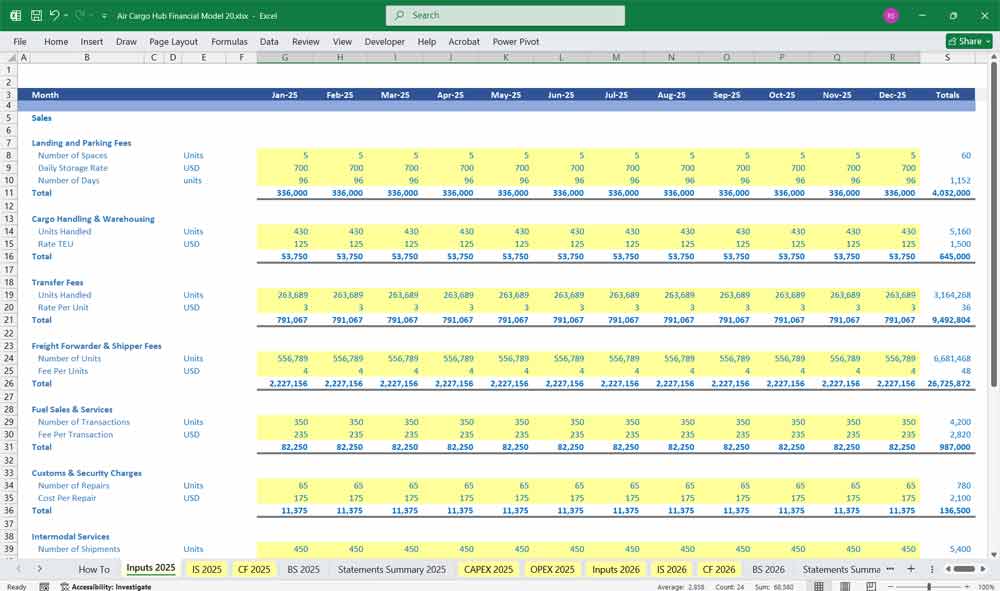
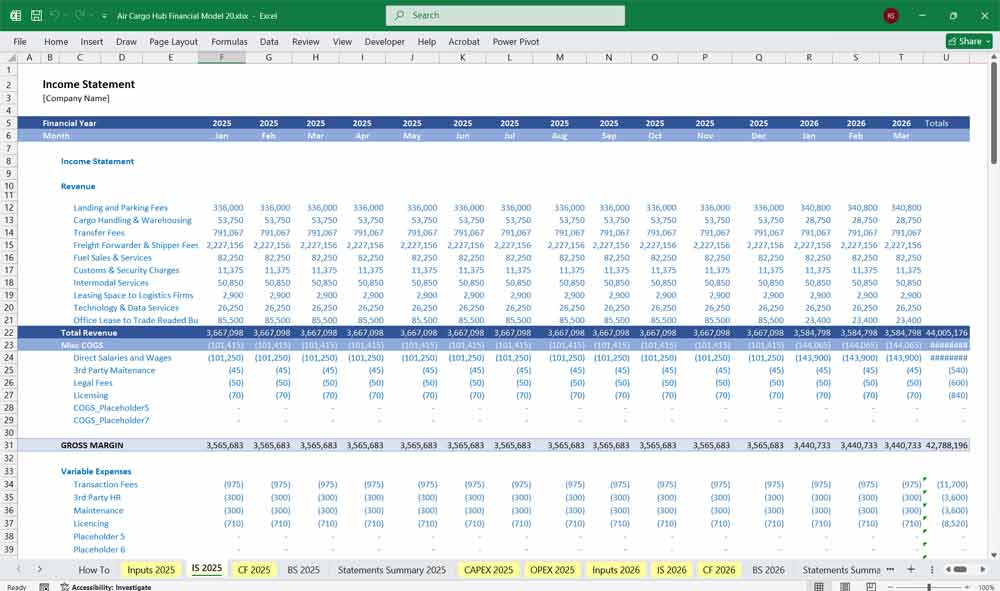
Air Cargo Hub Cash Flow Statement
Operating Activities
Cash Receipts:
All revenue items from income statement
Adjusted for changes in working capital (Accounts Receivable, Payables)
Cash Payments:
Salaries, fuel procurement, utilities, services
Taxes paid
Net working capital adjustments
Investing Activities
Capital Expenditures:
Runways, taxiways, terminals, IT systems, warehousing infrastructure
Expansion CapEx (e.g., new cargo terminals, automation tech)
Asset Sales (if any)
Financing Activities
Debt Issuance/Repayment
Equity Inflows
Interest Paid
Dividends Paid
Free Cash Flow
Operating CF – CapEx
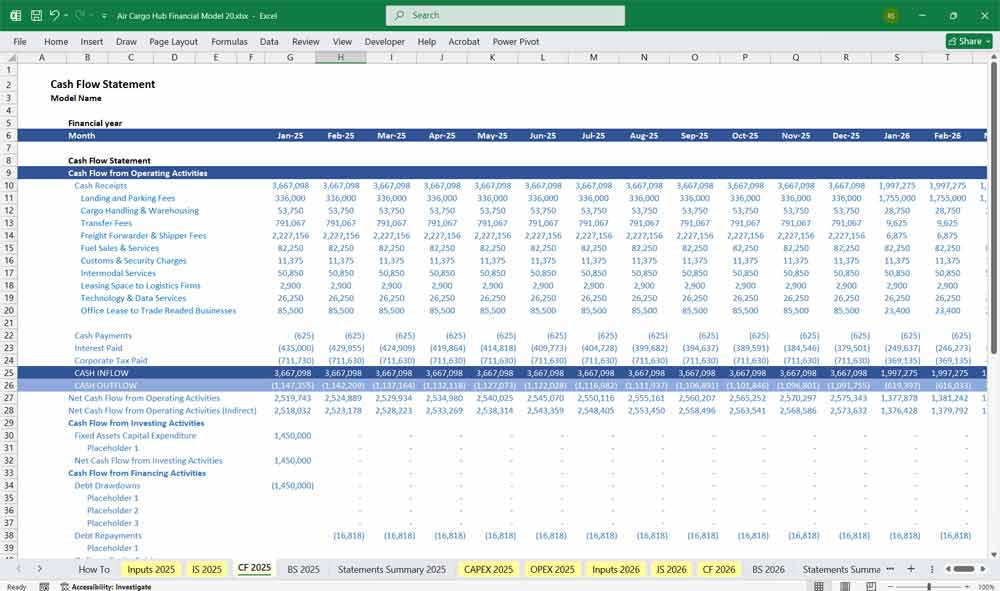
Air Cargo Hub Balance Sheet
Assets
Current Assets:
Cash & Cash Equivalents
Accounts Receivable (airlines, logistics firms, etc.)
Inventory (fuel, spare parts)
Prepaid expenses
Non-Current Assets:
Property, Plant, & Equipment (PP&E)
Runways, terminals, fuel farms, warehouses, trucks
Intangible Assets (licenses, software systems)
Right-of-Use Assets (if leased infrastructure)
Liabilities
Current Liabilities:
Accounts Payable
Accrued Salaries
Short-term Debt
Taxes Payable
Non-Current Liabilities:
Long-term Loans or Bonds
Lease Liabilities
Deferred Tax Liabilities
Equity
Share Capital
Retained Earnings
Revaluation Reserves (if applicable)
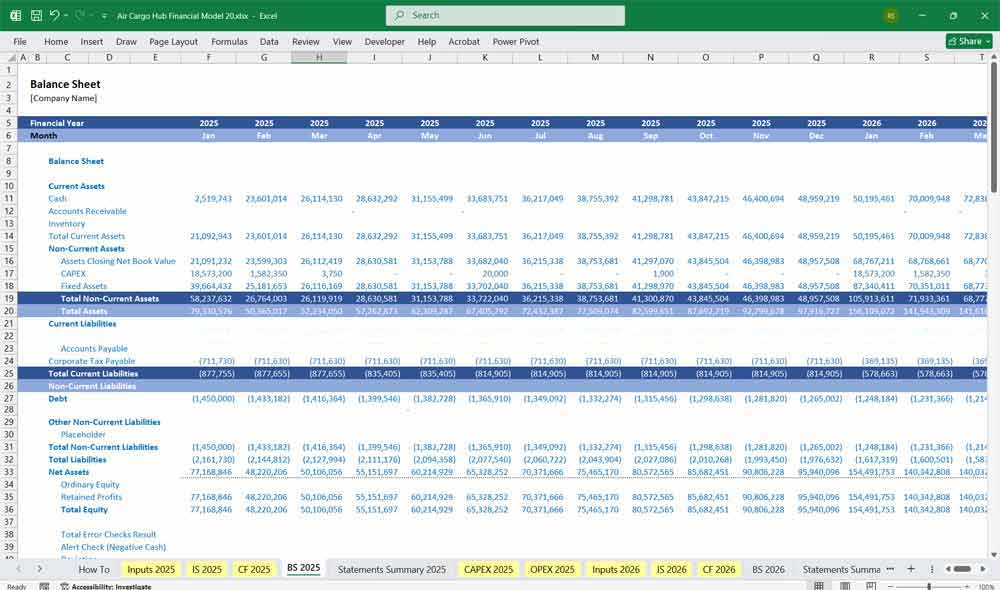
Capital Expenditure (CapEx): Initial investment in infrastructure, hardware, and construction.
Operational Expenditure (OpEx): Ongoing costs for maintenance, utilities, staffing, and software.
Cost per Rack: Total cost of operating a single server rack, including power, cooling, and maintenance.
Power Usage Effectiveness (PUE): Ratio of total energy used to energy delivered to IT equipment (lower PUE = better efficiency).
Key Financial Metrics for an Air Cargo Hub
Revenue Metrics
Monthly Recurring Revenue Predictable income from ongoing services like Cargo Handling & Warehousing, Freight Forwarder & Shipper Fees.
Revenue per Handled Units: Average income generated per package or per ton.
Revenue per Acre Leasing: Income generated per acre of physical space. Long-term lease income (warehouses, office space, cold storage, etc.)
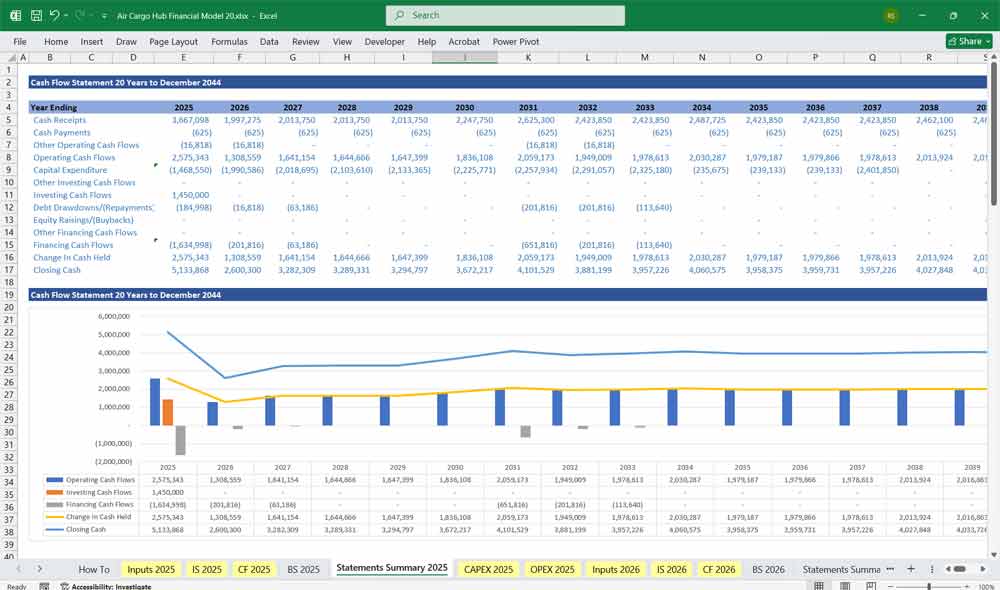
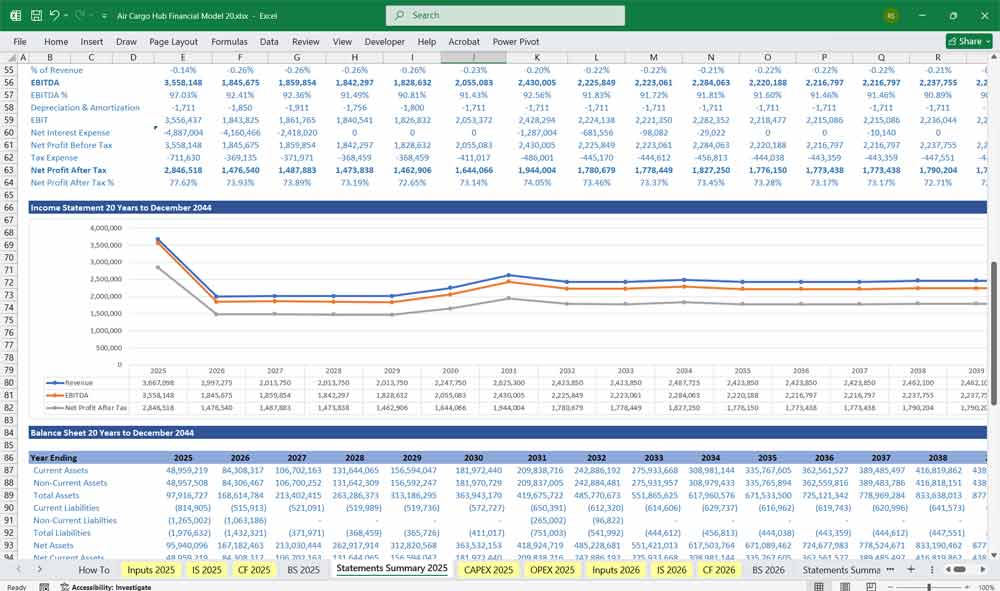
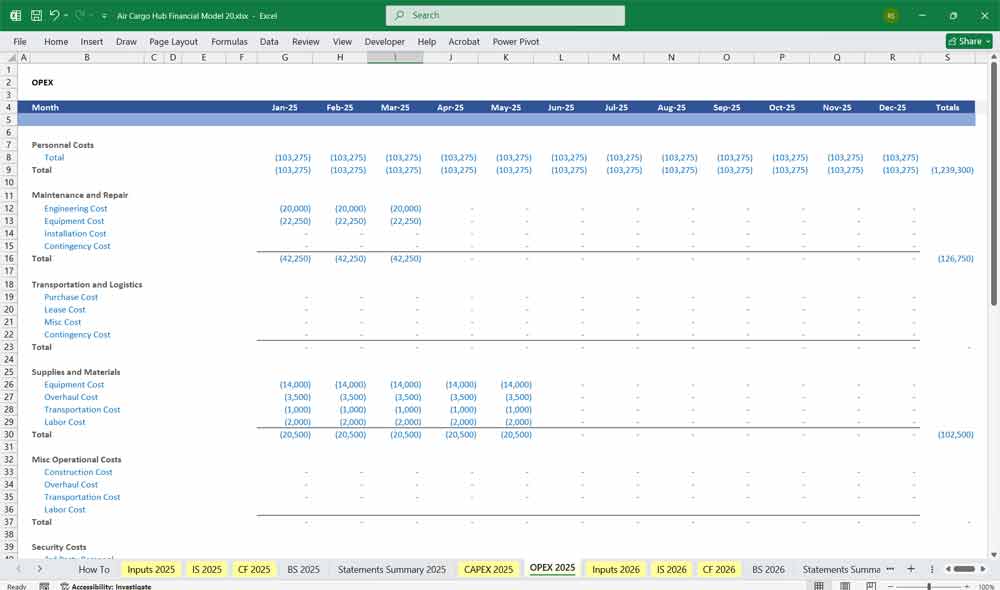

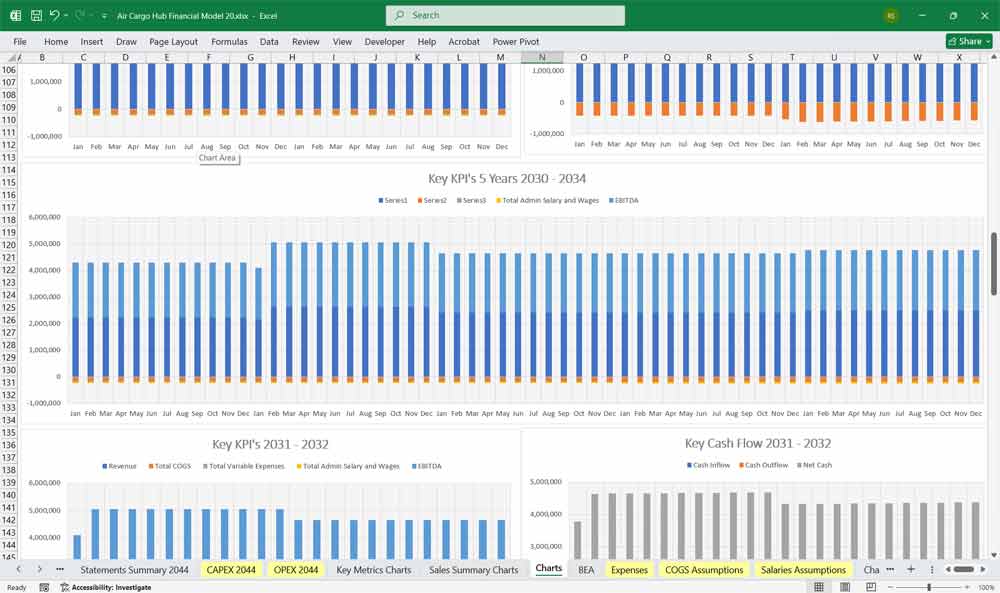
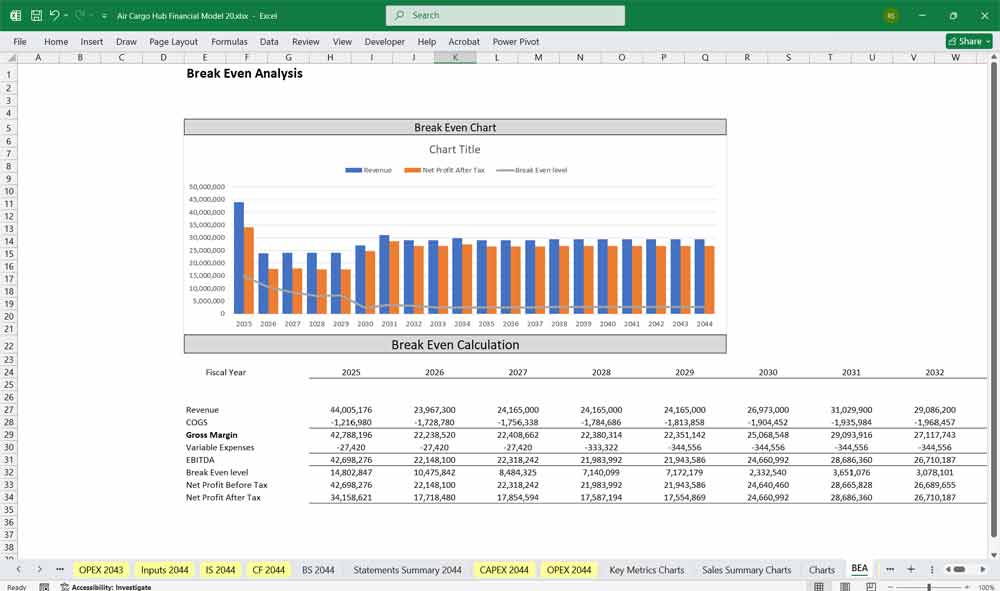
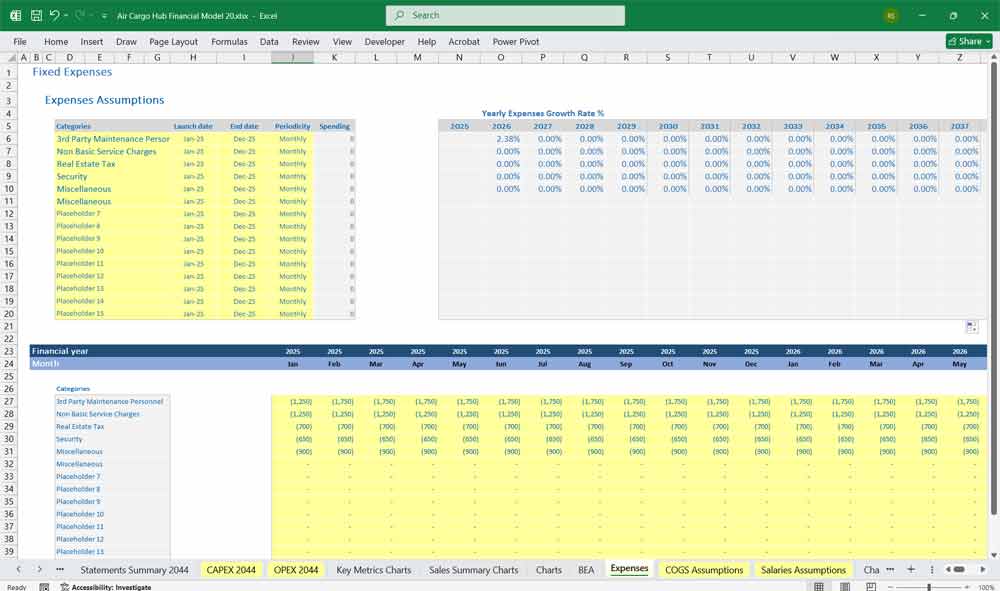
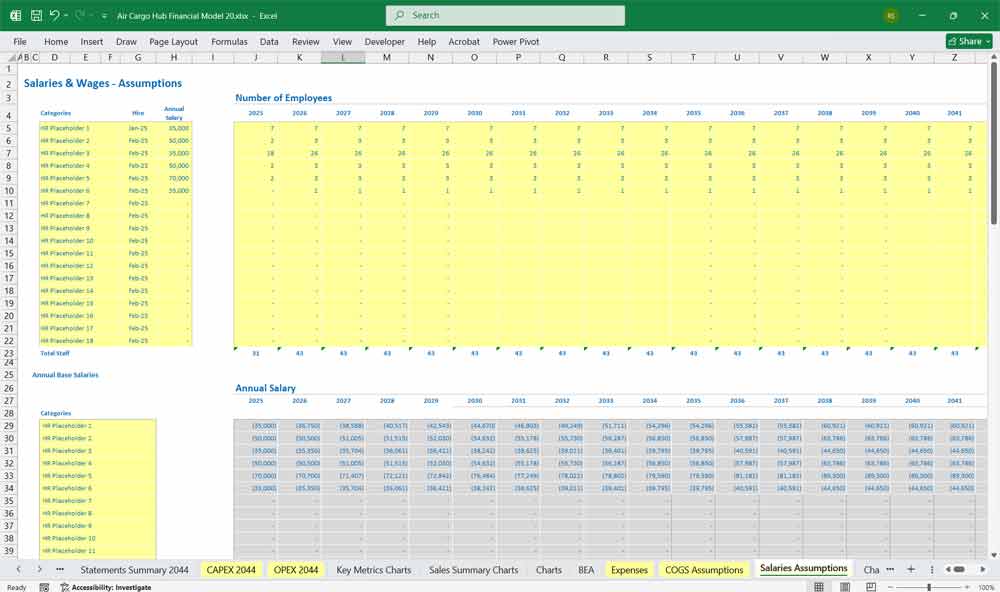
Final Notes on the Financial Model
This 20 Year Air Cargo Hub Financial Model must focus on balancing capital expenditures with steady revenue growth from diversified services. By optimizing operational costs, and power efficiency, and maximizing high-margin services like Landing & Parking Fees, Cargo Handling & Warehousing, and Freight Forwarder & Shipper Fees, the model ensures sustainable profitability and cash flow stability.
Download Link on Next Page
